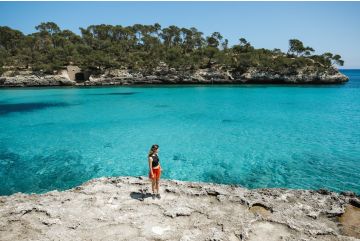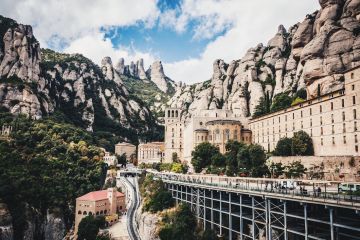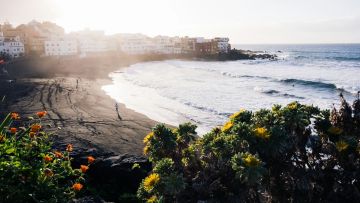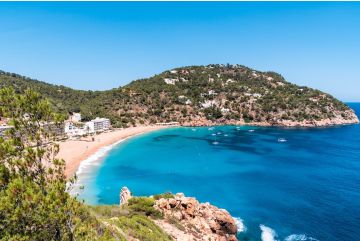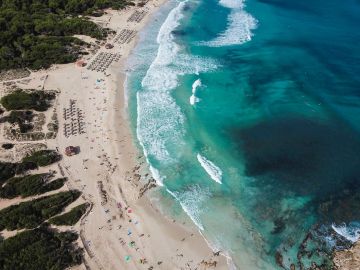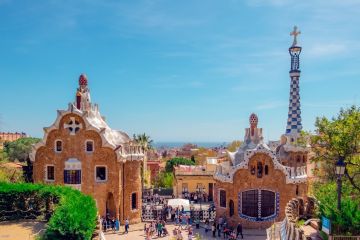Barcelona impresses with its architectural masterpieces, endless Mediterranean landscapes, perfect sandy beaches, and emerald hills. Come here to admire medieval churches and baroque palaces, delight classic squares and modern buildings, and explore art museums and natural beauties of this ancient city.
Visit the best Barcelona attractions:
- Sagrada Familia
- La Rambla
- Park Guell
- Guell Palace
- The Gothic Quarter
- Casa Batllo
- Els Quatro Gats
- Tibidado Mountain
- La Pedrera
- Catedral de la Santa Cruz y Santa Eulalia
- Palau de la Virreina
- Placa de Catalunya
- The Barcelona Zoo
- Picasso Museum
- Montjuic Mountain and Fort
- The Boqueria Market
- L'Aquarium Barcelona
- Casa Vicens
- Basilica de Santa Maria del Pi
- Mirador de Colom
- Placa Reial
- Placa de Sant Jaume
- La Fundacio Joan Miro
Sagrada Familia
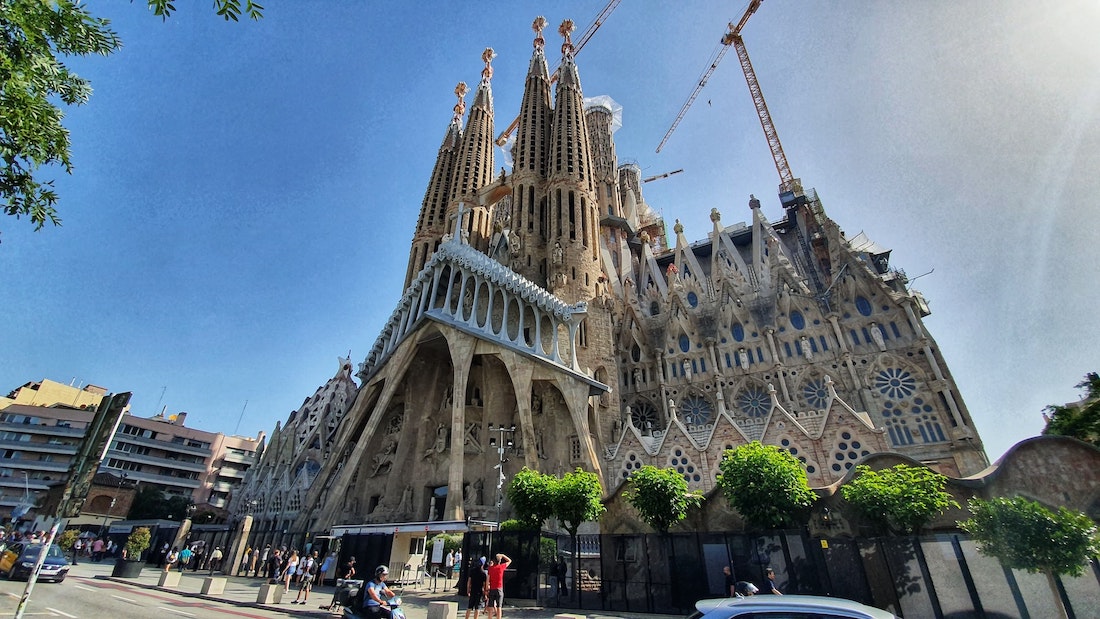
Author: Pavol Svantner on Unsplash
Sagrada Familia is the main symbol of Barcelona and one of the most unusual sights in Europe and even in the world.
The full name of the temple is Temple Expiatori de la Sagrada Familia. The main architect of the building is Antonio Gaudi.
The idea to create a cathedral did not belong to Gaudí, but to the charitable organization Associació de Devots de Sant Josep. The temple had to be built in a neo-gothic style. The first architect was Francisco del Villar. He was replaced by Joan Martorell, who soon abandoned the project and recommended Antonio Gaudí as chief architect. Gaudi officially assumed this position in 1884.
Initially, the project budget was small. The temple was planned to have a modest size and classical forms. Nevertheless, Gaudi persuaded the management of the funding organization to release him from any creative restrictions and began to work actively. The original humble project was completely redesigned and the changes were accompanied by a massive anonymous donation. The great building has begun.
Gaudi devoted 40 years of his life to the construction of the cathedral. Creation of the masterpiece has become the main goal of his life. Gaudi lived and worked in the workshop, which was located inside the temple.
How to get to the Sagrada Familia
The easiest way to get here is by metro, the station is called Sagrada Familia.
Opening hours and entrance fees
From November to February the temple is open from 9.00 to 18.00.
In March it is open from 9.00 to 19.00.
From April to September you are welcomed here from 9.00 to 20.00, and in October from 9.00 to 19.00.
December 25 and 26 and January 1 and 6 the temple is open from 9.00 to 14.00
You may buy tickets at the box office or online.
You may also buy a guided tour with priority access during which the professional guide will tell you the fascinating stories about this Barcelona brilliant.
Opening hours of the Gaudi Museum and prices
The Gaudi Museum is open from October to March from 10.00 to 18.00, from April to September from 9.00 to 18.00.
On December 25 and 26 and January 1 and 6, the museum is open from 9.00 to 14.00
The entrance to the museum costs 5.50 euros.
Please note that it is forbidden to enter the temple and museum with suitcases and backpacks. There are no left-luggage offices for bulky luggage in the cathedral but there are storage rooms for backpacks.
La Rambla
The main walking street of Barcelona is called La Rambla.
The boulevard starts in the city center, in Placa de Catalunya, and ends at the monument to Columbus. And then there is the promenade, the city port, and the beaches. The boulevard is partly pedestrian, and partly open for cars. Sometimes during the holidays, the boulevard is closed to give people more space to walk and have fun.
If you are looking for a good mood - go to the Rambla. If you want to buy an interesting souvenir, there are nice souvenir shops on the Rambla. If you want to have a tasty meal - the restaurants and cafes of the Rambla are at your service. Learn Spanish - an hour in the crowd in the middle of the Rambla and you know ten new phrases. If you don't know what to do - Rambla will decide everything for you.
On both sides of the boulevard buildings of the 18th and 19th centuries stand. And if you turn off the boulevard, you will see other popular and bright attractions - the Boqueria market, the Royal Square, the Guell Palace, or the Corte Ingles department store.
Best La Rambla Attractions
The boulevard consists of several segments - Canaletes, Rambla dels Estudis, Rambla de Sant Josep, Rambla dels Caputxins, and Rambla de Santa Mònica. Walking along the Rambla, you need to look around attentively, otherwise, you can miss something interesting. Here in Barcelona, something interesting is waiting for you on every corner.
Fountain de Canaletes
A drinking fountain was constructed near Placa de Catalunya in the 19th century. The inscription on it says that whoever drinks from the fountain will fall in love with Barcelona and return there again. Check if it's true or not.
Esglesia de la Mare de Deu de Betlem or Betlem Church
The standard of the Spanish baroque has been adorning the Rambla since 1732. You can admire the church from the outside, or you can go inside and see the exquisite statues and vaulted ceilings.
Rambla de les Flors
The boulevard is decorated with flowers and the Palace of the Vice Queen of Peru (Palau de la Virreina), which was constructed here in 1775. The outwardly discreet façade hides a thousand details of the baroque interior, so make sure you go inside. The entrance is usually free. Inside you will find a center of contemporary culture and exhibitions of contemporary artists and photographers.
Boqueria Market or Mercat de la Boqueria is not only a place with a huge selection of quality products, but also a real piece of architectural art. The market has been standing here since the 12th century. Today it is a popular tourist attraction where you can see what people like to eat in Barcelona and even buy something at a good price. Please notice that in general the prices in the market are quite high, so it will be cheaper to buy the same stuff in an ordinary supermarket. But does the supermarket offer to cook the freshest seafood for you or squeeze fresh juice just for 1 euro?
You may choose one of gastronomic tours such as Paella Cooking Experience & Boqueria Market Tour for 58 euros or Half-Day Spanish Cooking Class & Boqueria Market Tour for 94 euros. Taste Barcelona!
Rambla dels Caputxins, Liceo Theater and Joan Miro mosaic
Mosaics by Joan Miro have been decorating the boulevard since 1976. The mosaic is made in the surrealistic style, and one of the pieces of the mosaic even has the artist's autograph.
The House of Bruno Quadras or the House of Umbrellas was built in the Art Nouveau style and attracts visitors with unusual decor, for example, a statue of a Chinese dragon on one of the facades.
The Liceu Theater or Teatre del Liceu is one of the main opera houses in Barcelona and even Spain. Fyodor Chaliapin, Alfredo Kraus, Montserrat Caballe, Placido Domingo, and other golden voices performed here. In 1994, the theater burned down and all its chic interior was damaged. All of Spain collected funds for its restoration and today we have the opportunity to see its former beauty with minor changes and the same acoustics.
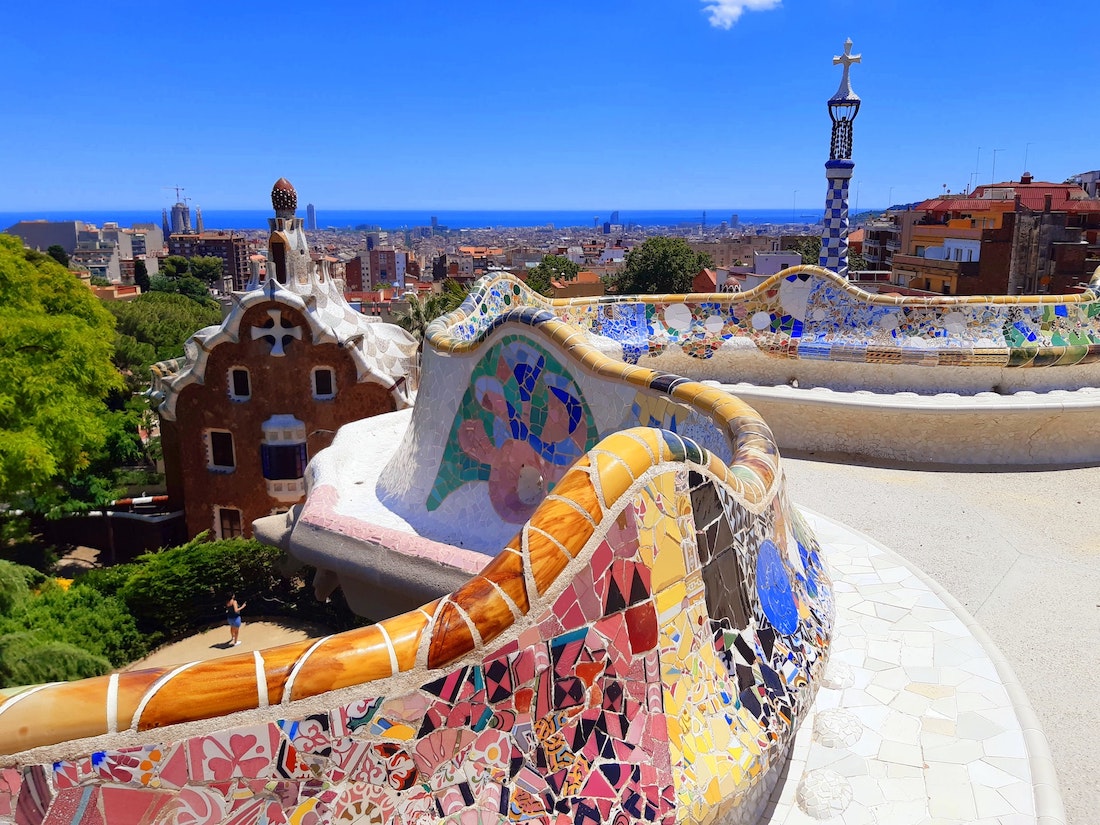
Author: D Jonez on Unsplash
Palace Güell or Palau Güell - an elegant building built by Antonio Gaudi for a major businessman Eusebi Güell. Park Güell was also designed for him. Gaudí mixed the neo-Gothic style with Art Nouveau and added a pinch of his endless imagination. It is difficult to see the building from the side, because the street is quite narrow, so it's better to go inside. The entrance costs 10 euros.
Rambla Saint Monica and Columbus Monument
The section of the boulevard that leads to the sea is named after Saint Monica. It borders the Portal de la Pau square, in the center of which an 80-meter monument to the navigator Columbus stands. And then stretch your hand forward to the sky and enjoy the promenade and beaches, the city port with hundreds of ferries, liners, ships, yachts, and boats, and the endless blue sea.
Best things to do in Barcelona on the Rambla
Study architectural styles
You can start with the Gothic church of Santa Maria del Pi (Basílica de Santa Maria del Pi). You will need a couple of minutes to get to the Cathedral of Saint Eulalia situated on Pla de la Seu. Then admire the King's Square, built in the style of unobtrusive classicism, with a hint of gothic and baroque style. By the way, black lights on the square were installed by Gaudi, this was his first order from the city municipality. And after that, you may admire the Spanish baroque looking at the Palace of the Vice-Queen and the Church of Our Lady of Bethlehem. Well, at the end of the walk, you need to dive into the world of modernism and the Güell Palace under the strict guidance of Gaudi.
Immerse yourself in the world of shopping
The Maremagnum mall introduces us to modern Barcelona-style architecture and gives you the opportunity to buy a dress in the very center of the city. It is located at the very end of the Rambla near the city's port. The building seems to hang over the water, and the Mediterranean Sea is reflected in the mirrored walls. This is not the biggest mall in Barcelona, but one of the most unusual. You can sit in front of it, admire the sea, seagulls and yachts, study the fish in one of the largest aquariums in Europe, then go shopping in popular stores, and at the end have a seafood dinner with a gorgeous view of the sunset sea and the city.
The mall is open every day, even on Sundays when others are closed. But due to the location, there are always a lot of people here, so be prepared for crowds.
If you like souvenirs, a walk along the Rambla will fill your bag with a lot of interesting things. Some sell classic magnets and postcards, some offer you to buy more serious items such as bijouterie and jewelry, you will also find clothes and shoes, accessories, paintings, books, posters, dishes and even pieces of furniture - whatever you can imagine.
Have fun with street performers
There is just no one on the Rambla - artists paint portraits, singers sing serenades, and musicians play along with them on the mandolin, mimes depict people passing by, statues of Dali, Columbus and Galileo stroll imposingly, and flamenco dances passionately nearby. By the way, if you want to see the hottest flamenco in Barcelona, check out Tablao Cordobés at La Rambla 35 - there you will find a stylish interior, delicious food and an amazing show.
Best hotels of La Rambla
If you want to live in the very heart of Barcelona and breathe in the aroma of Barcelona every morning, standing on the balcony, stay in La Rambla. All key attractions and best beaches are located nearby. In addition, there are plenty of public transport stops and even several metro stations.
Double room in a four-star hotel costs 200-300 euros.
Budget double room costs 100-150 euros.
The five-star Sonder DO Plaça Reial will allow you to find out what true luxury is. Here you will find the historical interiors of the hall, stylish rooms with magnificent views, a restaurant with exquisite decor and interesting menu, a spa and fitness center, as well as first-class service.
If you like unusual decor, check out the five-star Hotel Bagués. Rooms are decorated with decorations from the Masriere Museum, the balcony offers breathtaking views of the center of Barcelona, the restaurant serves Mediterranean cuisine, and on a hot day you can cool off in the rooftop pool.
Gaudi fans will love the 3-star Gaudi Hotel, some rooms here are facing the roof of the Palau Güell.
An excellent budget option is called Barcelona House. Perfect location, comfortable rooms, wonderful view from the windows are combined with one of the lowest prices in the area.
Another great budget option is the Hotel Lloret Ramblas. The hotel is located in a historic building of the early 20th century, the rooms have everything you need for a comfortable stay, and popular attractions and the sea are within walking distance.
Park Güell
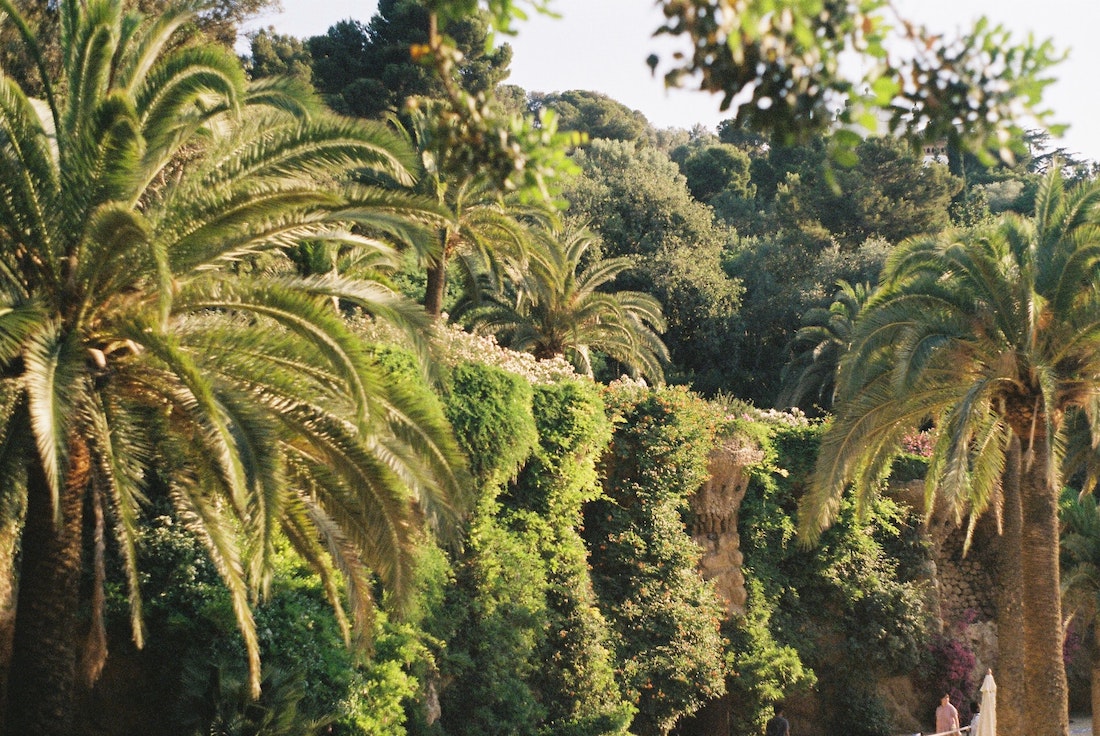
Author: Adora Goodenough on Unsplash
If you came to Barcelona to understand what Antoni Gaudí's fantasy is capable of, Park Güell will show you this. But even if you came here just to soak up the sun, do not miss the opportunity to see this miracle.
The garden city
The idea of the concept of "garden city" was that the industrial society and the traditional cities were heading toward their decline. Therefore, in the future, cities will combine the best qualities of a modern city and the countryside. There should be a large park in the center of the city and residential areas around it. Plants, factories, and agriculture were moved out of the territory of the garden city. The idea spread around the world and in 1901 the Catalan businessman Eusebi Güell decided to implement it in Barcelona. Antonio Gaudi was invited as the chief architect.
Active work was carried out for more than 10 years. Several houses were erected in 1906. It was assumed that buyers would gladly buy up luxury properties, but this did not happen. Gaudi himself bought the first house and lived in it until 1925. The second one was bought by a friend. And the third was bought by the author of the idea, Eusebi Güell, who made the mansion his own residence. Today, the Gaudi mansion houses the Gaudi Museum.
It should be admitted that attempts to build garden cities and populate them with people have been made in different countries but none have been successful. The most successful garden city project was the capital of Australia - Canberra. It is even unofficially called the forest capital because of the abundance of vegetation in the city.
Architecture of Park Güell
Work on the park began in 1901. The land on the hill was bought, the slopes were strengthened, and the main terrace was prepared.
The first major project was the famous bench that circled the main terrace. It is shown on the most famous photos of Barcelona - blue-orange mosaic bench, behind it, gingerbread roofs of the central houses, and then a panorama of Barcelona, turning into the Mediterranean Sea. To decorate the bench, the workers had to collect potsherds, broken dishes and fragments of old tiles all over the city, even in trash cans.
Another mosaic decoration of the park is a salamander that adorns one of the stairs leading to the terrace.
The central entrance to the park is decorated with two low houses of a very unusual shape with even more unusual roofs and spiers. Their style is reminiscent of traditional Danish or Swedish architecture, but looks like it was made from gingerbread dough and decorated with glaze.
The Hall of a Hundred Columns, which, by the way, has only 86 columns, but this does not spoil it at all. The hall is decorated with modest Doric columns, but the ceiling, on the contrary, has an intricate "layered" shape and is generously decorated with mosaics. The entrance to the Hall of a Hundred Columns is decorated with a large mosaic medallion with a snake's head. In addition, the Hall of a Hundred Columns has very good acoustics, so if you decide to sing, do not hold back.
Along the walking alley, which runs around the main square of the park, the so-called Bird's Nests are built. These structures are inscribed directly into the hill on which the park stands. Huge "nests" are lined with small stones, and sprawling palm trees grow behind them.
How to get to Park Güell
The nearest metro station to the park is called Lesseps. You have to walk about a kilometer from here to the park. If you don't want to walk, wait for the tourist bus that runs between the station and the park entrance.
Another metro station, Vallcarca, is located about one and a half kilometers away.
Timetable and prices
The park is open all year round.
The tickets are available for sale from 9.30 am to 5.30 pm.
You may purchase the ticket at the box office or buy it online.
Regular online entry ticket costs 13 euros.
Park Guel skip-the-line ticket and the guided tour costs 24 euros.
You may also buy combined Skip-the-Line Sagrada Familia & Park Güell Guided Tour for 82 euros. It allows you to visit the popular Barcelona attractions avoiding long lines and learn more interesting facts about the life and art of Antonio Gaudi.
Güell Palace
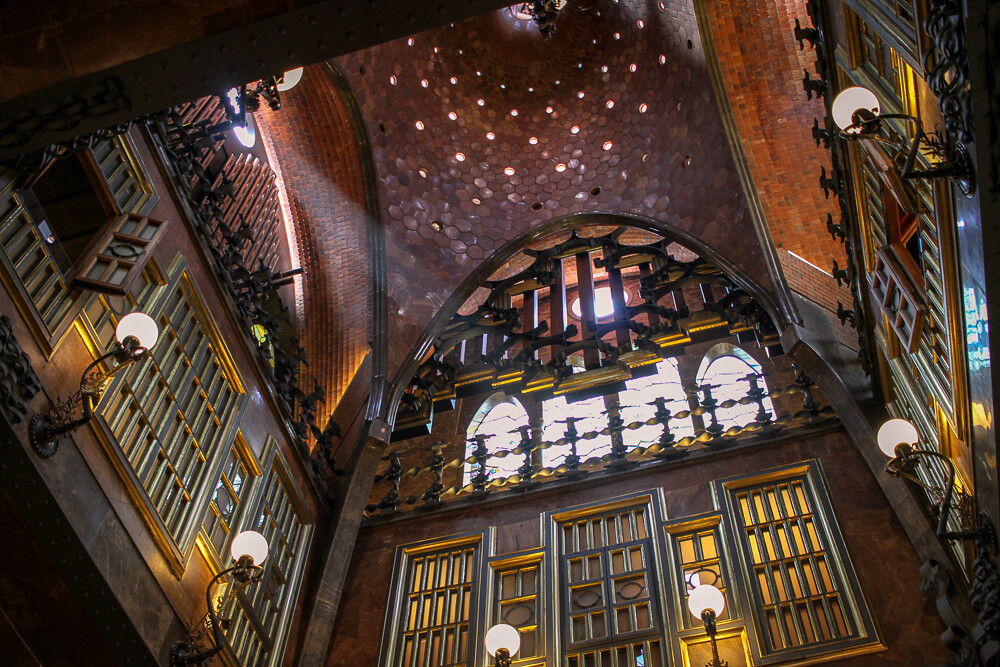
Author: Matías Callone on Unsplash
Güell Palace or Palau Güell was built for a major Catalan businessman Eusebi Güell, the same one who ordered the construction of Parc Güell.
The result is a real castle, made of stone and marble, decorated with columns, frescoes, and many forged elements. The author's signature style is unusual chimneys on the roof, which turn it into a kind of wonderful stone garden.
This is one of the very first projects of the architect, at that time Gaudí was just probing for his style. The palace has the features of a Venetian palazzo, thanks to a large number of windows, but otherwise, the style is very specific, and the unusual chimneys stylistically transport you to Park Güell.
Despite its modest size, the palace has spacious halls with high ceilings, which are filled with light. Unfortunately, the building is located in such a place that it is almost impossible to see it from different sides. But you can try to walk around it, and then go inside for 10 euros and look at the unusual interiors.
Timetable and prices
From 1 April to 30 September Palau is open from 10 am to 8 pm, and the last entry is 7 pm.
From 1 October to 31 March Palau is open from 10 am to 5.30 pm, the last entry is 4.30 pm.
You may purchase the ticket at the box office or buy the online ticket in advance. The online ticket costs 13 euros.
The most complete full day private tour with Sagrada Familia and Park Guell costs 201 euros. This guided tour will show you the best of Barcelona's heritage, architecture, and gastronomy. It combines a walking tour with taxi rides to the most interesting destinations. It is a perfect choice for first-time visitors who want to see all the highlights in one day with a personal guide who will let you discover parts of the city you would likely miss on your own.
The Gothic Quarter
Today the whole life of Barcelona is concentrated on La Rambla, but a couple of centuries ago the city center was in the Gothic Quarter.
The Gothic Quarter or Barri Gotic is located a minute's walk from La Rambla and just like La Rambla starts from Plaça de Catalunya, it just goes a bit the other way.
You should go here to admire the masterpieces of Gothic architecture, some buildings are 400 or even 500 years old, beautiful narrow streets where you forget what year it is now, squares where pigeons are waiting for you to bring them tasty crumbs, as well as cozy restaurants with an unusual menu.
Most of the buildings in the quarter were constructed in the 14-15th century, but the development of the quarter began much earlier. Between the streets of Carrer de la Tapineria and del Sots-Tinent Navarro, you can still find the remains of the ancient Roman wall. Pay attention to St. James Square, in ancient times the Roman Forum stood there - the most important place in the whole city.
Best attractions and things to do in the Gothic Quarter
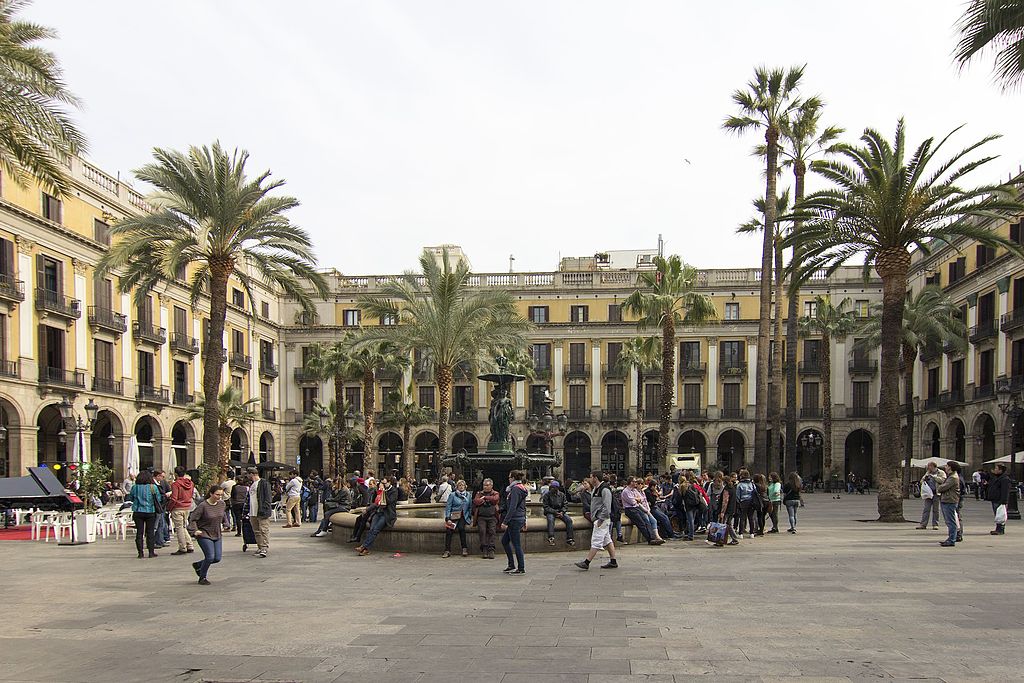
Author: Sietze Kraak on Wikimedia
Cathedral of the Holy Cross and Saint Eulalia
The main cathedral of Barcelona is called the Cathedral of the Holy Cross and Saint Eulalia, while the most popular is the Sagrada Familia. The construction of the cathedral began in 1298. The Gothic Quarter is a rare place where such dates can be found.
In one of the courtyards 13 white geese live, some say that this is how old Saint Eulalia was when she was martyred. And under the main altar, a sarcophagus with her remains is kept.
The cathedral is best visited in the late afternoon. Then, going up to the observation deck on one of the towers, you can admire Barcelona in the pre-sunset rays, and in the evening you can see how beautifully the building is illuminated.
St. James Square
St. James Square or Plaça de Sant Jaume is the central square of the Gothic Quarter. There you will find several administrative buildings, as well as cafes and souvenir shops. In winter Christmas markets are held here, people arrange meetings on the square and if the citizens have protest moods, then they usually splash out on this square.
The square is named after the Church of St. James which stood here in the Middle Ages. Later it was demolished, but the name remained.
Interesting fact - the square is located in the Gothic Quarter, but most of the buildings were built in the style of classicism and renaissance. The buildings are lighter, the lines are calmer, and the decorations are restrained. You can observe columns and statues on some buildings, such as the City Hall, and they clearly indicate that the architect abandoned the Gothic and moved on to classicism.
Art Cabaret Four Cats
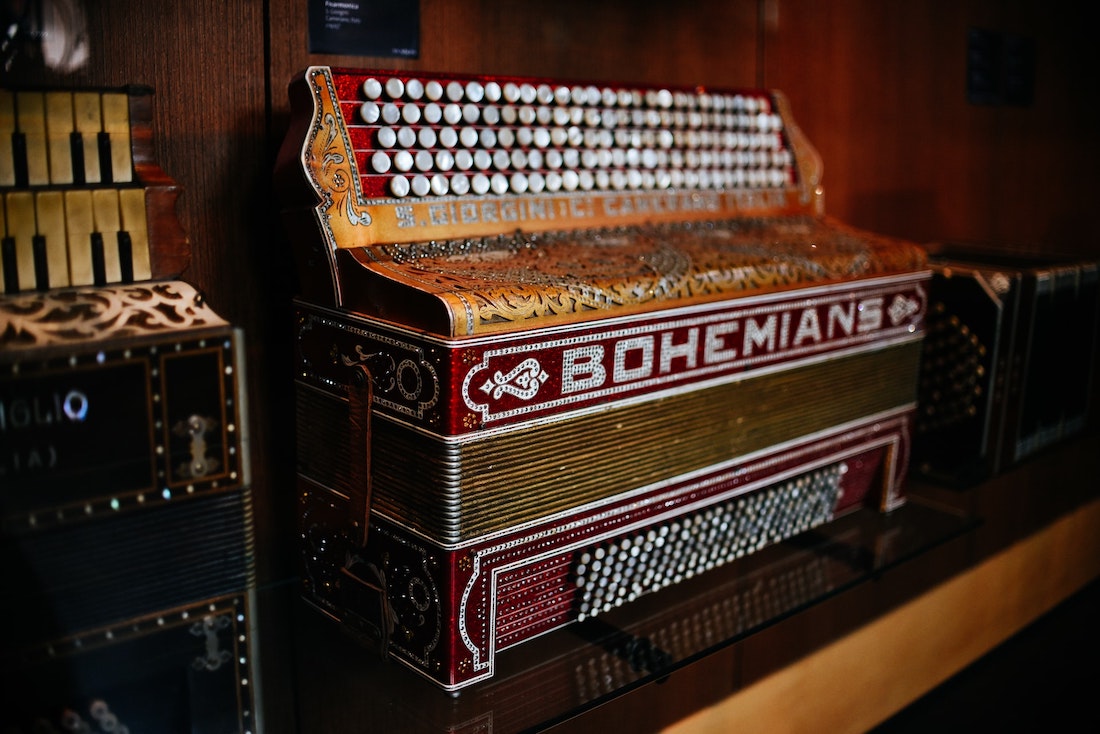
Author: Gaelle Marcel on Unsplash
Art Cabaret Four Cats or Els Quatre Gats was created in the likeness of the Parisian cabaret Black Cat and the entourage here is about the same. The cafe bar cabaret was opened in 1897 and immediately became popular with local bohemians, in particular Pablo Picasso and Antonio Gaudi. When the dictator Franco came to power, the building was demolished, but in 1970 the cafe reopened in the same place and in the same form. So Picasso defeated the dictator.
Art lovers will be interested to know that in Spain there was even a community of artists and artists, which was named "Els Quatre Gats" - in honor of this very cafe. The community included many avant-garde artists, including Picasso, whose first exhibition was held here.
If you're interested in modernist interiors, pop in here in the afternoon for dessert and coffee. If you want to watch the show, book a table, dress up and come in the evening, the cabaret is open every day from 1 pm to 1 am.
Royal Square
Royal Square or Plaça Reial is another square in the Gothic Quarter and again constructed in the style of classicism. Initially, there was a Capuchin monastery here, it burned down and at the end of the 19th century, a square was formed in its place. The buildings that surround it make it look like an elegant Italian courtyard with arches, galleries, and palm trees that grow in the middle of the square. Here you will find nice street cafes and cozy restaurants. Everything here creates an excellent mood so it is the perfect place to drink coffee and think about something pleasant.
Museum of the History of Barcelona
Museu d Història de la Ciutat Barcelona is located on Placa del Rey (do not confuse it with Plaça Reial, they are located 500 meters apart) and tells, as you might guess, about the history of Barcelona.
The museum has two parts - underground and above-ground. In the dungeons, you can get acquainted with the remains of ancient Roman structures, and see the ruins of walls, sewers, and water pipes. The dungeons are huge and you don't expect to see excavations of such an impressive size. Upstairs you will find the main exhibition with sculptures, coins, dishes, jewelry, clothing and footwear, furniture, weapons, and art.
The entrance costs 7 euros, and it is free for children under 16.
On Sundays from 15.00 to 19.30 admission is free.
Basilica of Santa Maria del Pi
Visiting the Gothic Quarter you are waiting for the Gothic buildings but in reality, you see that most of the buildings are constructed in other styles. B Basilica of Santa Maria del Pi is a real Gothic treasure. It is dedicated to St. Mary of the Pine. This place used to be a pine forest, hence the name. In honor of this fact, a pine tree was planted in front of the temple.
They say that the church stood on this place at the dawn of the second millennium, but this particular building was constructed in 1320, and then it was reconstructed several times. This church came through an earthquake, a powder explosion, a fire... Last time the temple was renovated in 2009. The architects tried to bring the appearance of the cathedral as close as possible to the original.
Pay attention to the unusual bell tower - it has eight corners and it resembles a massive pipe, especially from a distance. At the entrance you are greeted by a huge wind rose on the facade and a portal with columns, and then the lancet arches, stained glass windows, bas-reliefs depicting the Virgin Mary and biblical heroes, as well as Christian symbols, familiar to Gothic structures. There is an observation deck on the bell tower, from where a breathtaking view of the whole city opens.
Concerts are regularly held in the temple, where professional performers play music, the cost of the entrance is about 20 euros.
The entrance to the cathedral costs 4.50 euros, and the entrance to the observation deck costs 9 euros.
On Sundays, you can enter the cathedral for free, but try to dress decently, shoulders and knees should be covered.
Try one of the Gothic Quarter tours, for example 2-Hour Gothic Walking Tour for 25 euros. You may find dozens of marvelous tours along the Gothic Quarter. And one of the most incredible is Barcelona: Helicopter, Walking, and Sailing 360º City Tour. You will discover the best Barcelona attractions on a unique tour by land, sea, and air. You will enjoy a perfect stroll through the Gothic Quarter, see bright Rambla, learn about Casa Mila and Casa Batllo, admire the city on a panoramic helicopter flight and enjoy the city on an unforgettable coastal cruise.
Best hotels of the Gothic Quarter
If you want to live in the very center of Barcelona, close to the sea and at the same time in a relatively quiet area, choose the Gothic Quarter.
A spacious double room in a four-star hotel costs 150-250 euros.
A budget room in a two-star hotel costs 60-80 euros.
One of the best hotels in the Gothic Quarter is the five-star Ohla Barcelona. Here you will find exquisite interiors in a modern style, a wonderful view from the windows of the old buildings and streets of the Gothic Quarter, several restaurants, including Catalan cuisine, a rooftop pool, and an incredible view of the roofs of the houses and cathedrals of the Old Town, as well as a gym and sauna.
The 5-star Hotel Neri – Relais & Chateaux is housed in an 18th-century building. This is the ideal hotel for those who love the combination of old and new. The hotel building is a historical monument, and the rooms have absolutely everything you need for a good rest: comfortable beds, air conditioning, drinks, and, of course, stunning views from the windows. It features a lounge area, library seating, and a rooftop garden. This hotel also offers spacious, self-catering apartments.
The four-star H10 Madison 4* Sup offers stylish rooms decorated with natural materials, beautiful views of the squares and streets of the Old Town. Here you will find a Mediterranean restaurant and a rooftop pool with a large terrace where you may enjoy the most popular attractions of Barcelona from a bird's eye view.
One of the best budget options is Hostal Marenostrum. It is located at the intersection of the Gothic Quarter and the Ramblas, which means that almost any attraction can be easily reached on foot. The rooms have everything you need, including soundproofing, original design, and a wonderful view from the windows.
The 3-star Barcelona House offers an excellent location, modern rooms with comfortable beds, and delicious breakfasts.
Casa Batllo
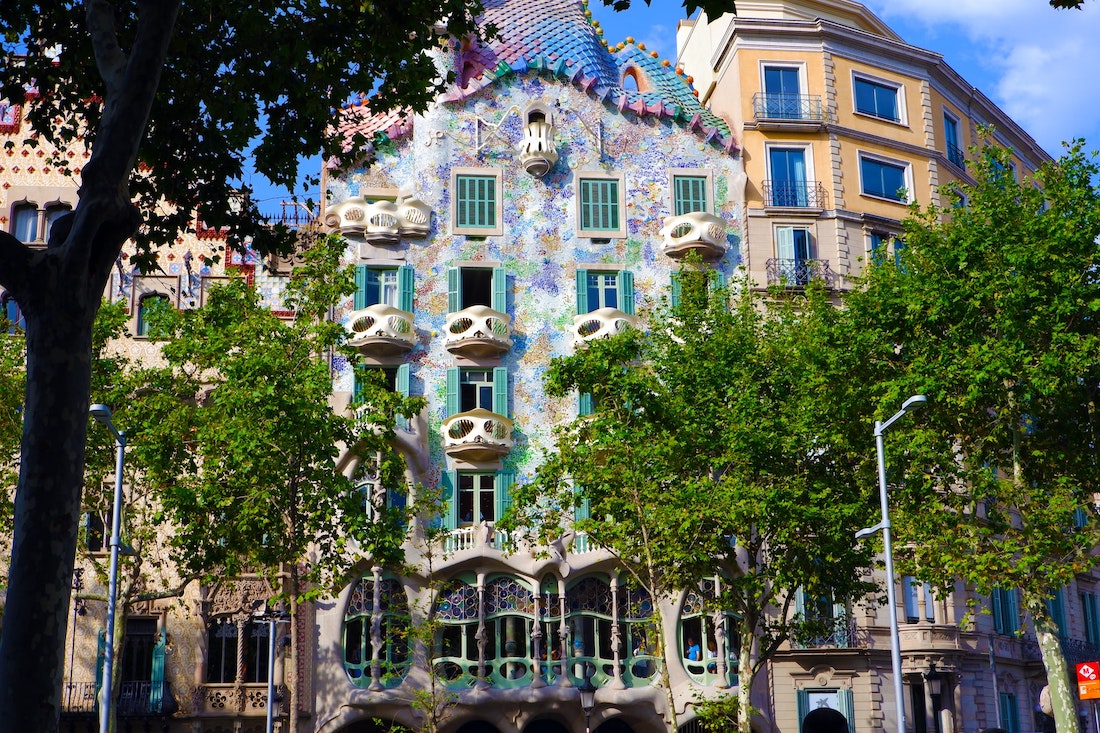
Author: Ruggiero Calabrese on Unsplash
One of the most popular creations of the genius Gaudi is located in the city center, 700 meters from Placa de Catalunya.
Gaudí built this house for the Catalan businessman Josep Batllo y Casanovas in 1877. Gaudi did not build from scratch but reconstructed an earlier building.
The architect completely redesigned the facades and balconies, added and replanned floors, built a terrace and an attic, and designed a courtyard. As with the construction of the House of Mila, he rethought the approach to ventilation of the premises, so that now the building can function without air conditioning even in summer. In addition, the windows are designed in such a way that the rooms are naturally lit almost all day long.
We can say that this work became a turning point in the creative way of Gaudí. During the construction of Casa Batlló, the master decided that he would no longer look back at existing architectural trends and stick to a specific style. From now on, Gaudi will follow only his own feelings and desires. Nevertheless, looking at Casa Batlló, one cannot fail to notice the features of Art Nouveau - smooth lines, large windows with decorated frames, and floral ornaments.
Architecture of Casa Batlló
The building has eight floors and a basement, as well as an attic and a terrace. Usually, this house is liked even by those who are not enthusiastic about the work of Gaudí. Therefore, if you want to explain to someone your love for the unusual style of Gaudi, show him this building first.
Batllo's house looks unusually smooth and somehow gentle. It seems to be floating down the street, the roof seems to flow down, and the colors are so soft as if the building is gently wrapped in mist. The architect specifically created this illusion by using different colors of facing tiles.
The windows in the building are of different sizes. They get smaller as they get closer to the roof. The windows on the second floor are skillfully decorated with stained-glass windows and framed in sea-green frames. The building itself is designed in such a way that the windows and balconies are very organically woven into the overall picture as if it were not a building, but a marvelous stone plant, where the floors are a stem, and the windows and balconies are flowers.
The roof of Casa Batllo is lined with tiles shimmering in the sun and looks like the scales of a dragon or lizard. At the same time, the color of the scales is a logical continuation of the facade color design. The roof has an irregular shape and is decorated with a tower on one side.
From the inside, the house looks no less unusual: huge halls, irregularly shaped arched ceilings, huge double doors decorated with stained glass windows, a lamp in the form of a sun, a patio well, and a white room resembling a cave. You never know what is waiting for you next.
Timetable and prices
The Casa is open from 9 am to 10 pm. The last entry is 8.45 pm.
You may purchase the ticket at the box office or buy them online.
The online ticket with an audio guide costs 35 euros.
You may buy a combined ticket to Sagrada Família, Park Güell, and Casa Batlló Tour for 169 euros.
Els Quatro Gats
Cafe-cabaret Els Quatre Gats or Four Cats was opened in this very place in 1897. The founders of the cabaret created it in the likeness of the famous Parisian cabaret Black Cat, which enjoyed crazy success with Parisian bohemia. Four Cats expected the same success, but this time with the Spanish bohemia.
For example, the regulars of the institution were Pablo Picasso and Antonio Gaudi. When the Spanish avant-garde artists decided to found their own community, they named it after this cafe - "Els Quatre Gats". Picasso was one of the founders and it was in this cabaret cafe that his first exhibition was held.
When the dictator Francisco Franco came to power, it was decided to demolish the cafe, because it is not worth having fun when there is a crisis on the street. But the cabaret reopened right after Franco left the government. This is how art defeated the dictatorship.
The cafe has a very original modernist decor, so if you want to get a closer look, come in the afternoon for coffee and cakes or sangria with canapés. If you want to listen to a concert or see a show, book a table for the evening.
Tibidabo Mountain and Amusement Park
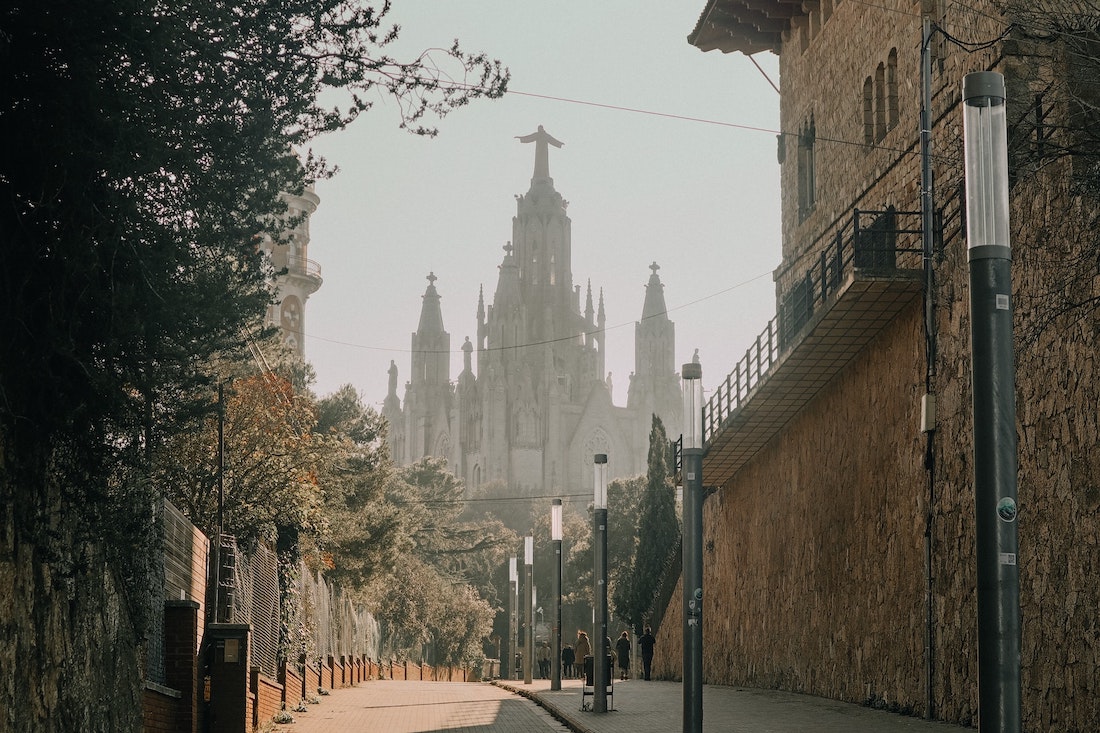
Author: Jorien van der Sluis on Unsplash
Mountain Tibidabo is the highest point in Barcelona.
It is a place where the landscapes of Barcelona, its beaches, and its surroundings open before your eyes from a height of 512 meters. You will see the majestic Sagrada Familia, and the noisy Rambla, along which a stream of residents and guests of the city flows, and the cozy Gothic Quarter, and Barceloneta with its fish smell.
Temple and observation deck on Mount Tibidabo
At the top of the mountain stands a beautiful Gothic temple, above which rises a statue of Christ the Savior. He raised his hands over the city as if blessing it.
The Gospels describe a situation when Jesus Christ fasted for 40 days in the desert, and Satan tempted Him. First, Satan offered food to Christ, tired of fasting, but He refused. Then he suggested that if Christ is God, then He can throw himself down from the cliff and nothing will happen to Him. But Jesus did not prove anything to the tempter.
Then Satan took Jesus up to a high mountain and showed Him all the kingdoms of the universe and said, “I will give You power over all these kingdoms and their glory, for it is delivered to me, and I give it to whomever I want; therefore, if You worship me, then everything will be yours."
To which Jesus answered him: "depart from Me, Satan. It is written: worship the Lord your God, and serve Him alone" (Gospel of Luke 4 chapter). Thus, Jesus showed that the real ruler of the entire universe is God, who created heaven and earth.
In memory of this passage, the inhabitants of Catalonia installed this statue of Jesus Christ. Under the feet of the statue is an observation deck where you can take perfect photos, or you can thank God for the amazing opportunity to see such beauty.
You can go up to the observation deck by elevator, and then by a small staircase.
Entrance to the temple is free. The entrance to the observation deck costs 4 euros.
Luna Park on Mount Tibidabo
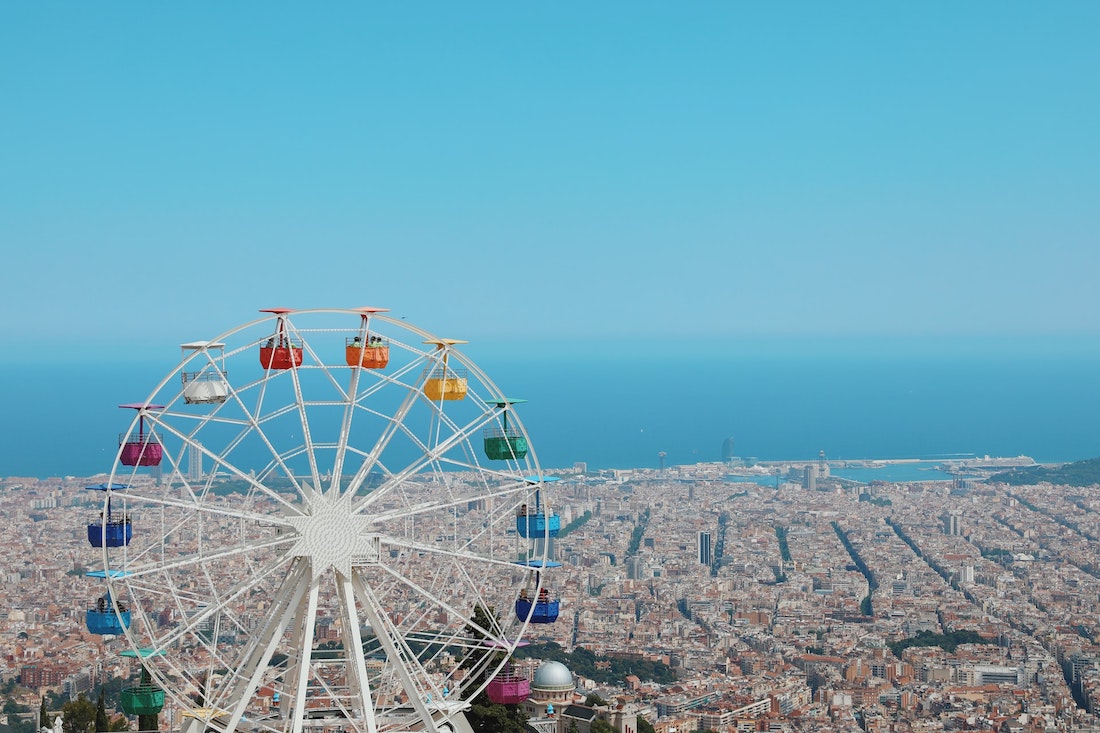
Author: Boris YUE on Unsplash
You will find a large square a little below the temple. There stands one of the oldest amusement parks in the world. There you will find attractions that will take your breath away, a park with rare plants, a theater and cinema, a cafe and a restaurant, and several museums.
Pay attention to several rides such as the Air Train and the Tibidabo Airplane which were built over a century ago, but don't worry, all precautions have been taken. But most of all the guests of the amusement park are attracted by the Ferris Wheel and it is no wonder. It is quite small but when you soar in the sky a unique view of the whole of Barcelona opens up from your cabin.
How to get to the temple and amusement park on Mount Tibidabo
There are several ways to get to the temple and the amusement park: taxi, bus, train, and funicular.
The easiest way is a taxi. The taxi from the city center will cost you 15-25 euros one way.
There is a more romantic way to get to Tibidabo. It is more difficult than a taxi but much cheaper, and more colorful.
Take the S1-S2 train at Plaza Catalunya. It takes you to the funicular station (Peu del Funicular). Take the funicular to the bus stop, and there take bus number 111, which runs every 10 minutes and stops right in front of the temple on Mount Tibidabo.
You may also buy a Private tour to Tibidado mountain. You will ascend Tibidado Mountain, enjoy the panoramic views of Barcelona, and spend free time in Tibidabo Amusement Park or the Temple de Sagrat Cor. The tour includes hotel pick-up and drop-off.
Whichever way you choose, wear comfortable shoes and take plenty of water. And get ready to be amazed.
Casa Mila la Pedrera
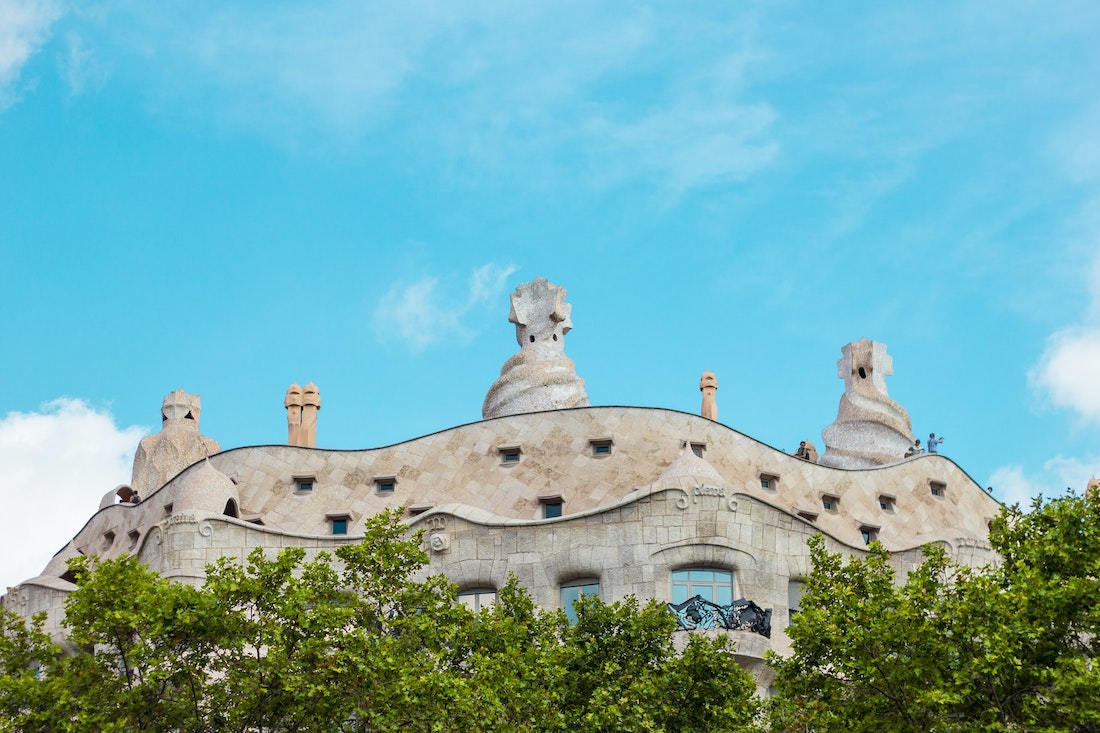
Author: Tyler Hendy on Unsplash
Many people go to Barcelona to enjoy Gaudí's masterpieces. First, the majestic Sagrada Familia appears before your eyes, then you explore Park Güell, and then it's time for the amazing Casa Mila.
This unusual house was supposed to become the usual home of the Mila family from Barcelona, but Antonio Gaudí took over the job. When Gaudi completed this construction, he completely switched to the Sagrada Familia and continued to work on the temple until his death.
House Mila has a strong facade, which the locals call "the stone pit" or "La Pedrera", which is decorated with wrought iron balcony railings. The building itself has a wave-like shape, it seems to be floating along the avenue. The building is crowned with a roof with a spacious terrace lined with mosaics and decorated with stone sculptures. Almost every room has a window, which allows the rooms to be naturally lit all day long, and a special ventilation system makes it possible not to use air conditioners even in the Barcelona heat.
The interior of the building is no less interesting. Inside there are several courtyards where you can relax in the shade, each room is full of light and it makes your spirits high. The stairs are rounded and planted with flowers, which gives the feeling of a garden indoors.
Today the building belongs to the bank Cayxa de Catalunya. But you can buy a ticket and go inside the building. The ticket price includes a walk through the courtyards, a visit to the apartment, in the style of the early 20th century on the 7th floor, as well as admission to the Gaudí Museum, which is located in the same building.
There is an observation deck on the roof from where you can admire the central part of Barcelona. The visit is also included in the ticket price.
Opening hours and prices
From November 4 to February 27, the museum is open every day from 9.00 to 18.30
From February 28 to November 1, the museum is open every day from 9.00 to 20.30
Check the official website for schedule changes.
The entrance ticket costs 22 euros. Children under 6 years old visit the museum for free.
Tickets can be purchased at the box office or you may buy them online. Online tickets will help you avoid lines.
How to get to Casa Mila
You can get here by metro. The station is called Diagonal. You can also take bus numbers 4, 5, 22, 24, 39. The stop is called Diagonal or Rosello.
Catedral de la Santa Cruz y Santa Eulalia
The cathedral was built in 1298. It was constructed on one of the squares of the Gothic Quarter called Pla de la Seu.
The building has a pronounced Gothic style, which means you go inside through a portal of marvelous beauty, carved turrets soar up, the facade is decorated with many stone details, you can endlessly look at the stained-glass windows, and the vaulted ceilings look amazing. In one of the courtyards, there is an unusual "green" fountain, and in the other, there are 13 white geese, which symbolize the purity of Saint Eulalia, who died a martyr's death at the age of 13.
One of the towers has an observation deck with a panoramic view of Barcelona. And in the evening the whole building is beautifully illuminated.
You may purchase tickets at the box office or buy online ticket. Online tickets cost 12 euros, children visit the temple for free.
Palau de la Virreina
The palace was built on La Rambla in 1775.
Construction began on the order of the Viceroy of Peru Manuel de Amat. The customer died before the construction completion, so his widow, Maria Francesca de Fivallière y de Broy, settled in the new palace.
The facade of the building looks strict and restrained, but inside it surprises with luxury and baroque chic.
The discreet Baroque building today serves as an exhibition center where you can learn about contemporary art, and in particular about photography and cinema. But the main thing you will see here is the baroque architecture with its unique forged gratings and intricately decorated balustrades. The decor will not leave you indifferent. Admission is often free, so be sure to check it out as some exhibitions may be paid.
Placa de Catalunya
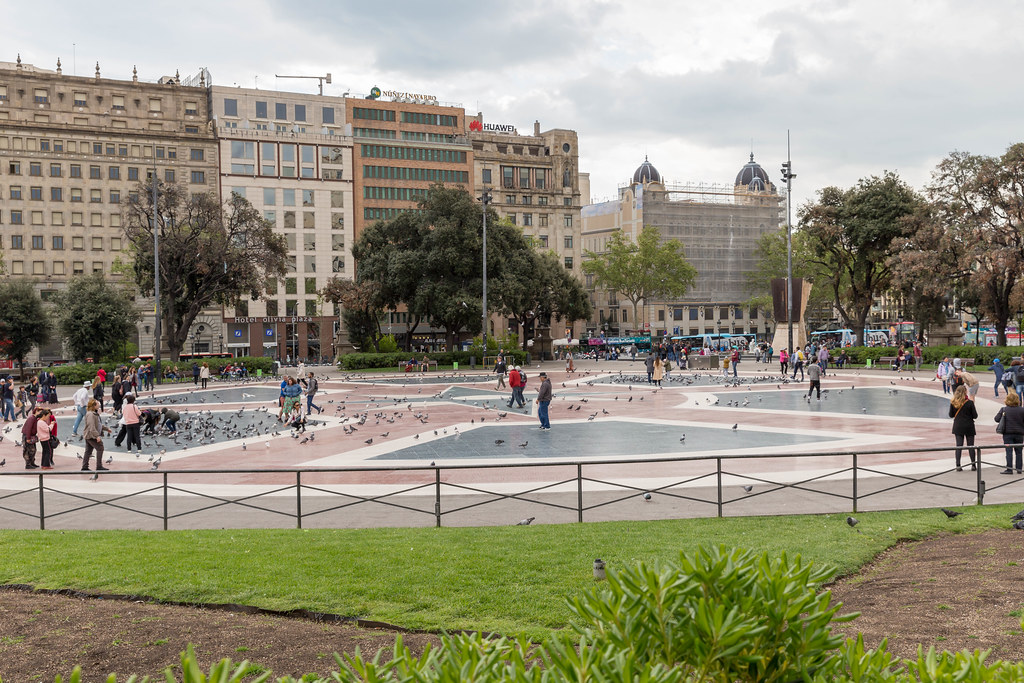
Author: Marco Verch on Unsplash
Barcelona's main square is called Plaza Catalunya or Placa de Catalunya. The Rambla Boulevard branches off from it and goes to the city port, promenade, and beaches. In general, the most central center of the city.
The area is paved with granite, planted with trees, and is surrounded by department stores, shopping centers, and cafes, as well as the buildings of several large banks.
Usually in Placa de Catalunya people make appointments or look for lost friends and relatives. If you are lost in the crowd, now you know where to go.
Shops and malls in Placa de Catalunya
There is a small shopping center El Triangle in the Placa de Catalunya, which sells goods of the most popular brands, and there you can also have a bite to eat in one of the small cafes.
Another mall is called El Corte Inglés. It is large, the selection of brands here is much wider than in El Triangle, and there is a large food court on the top floor where you can dine with a gorgeous view of the center of Barcelona.
The huge Apple Passeig de Gràcia store will interest you not only in MacBooks and iPhones, but also in its spectacular appearance.
The official store of FC Barcelona or Barça Store Passeig de Gràcia is located 300 meters from Plaza Catalunya at a Passeig de Gràcia 15. If you are a fan or have a friend who is not indifferent to the achievements of the football club, you can buy souvenirs there. Friends will be impressed.
Transport in Placa de Catalunya: metro, buses and trains
The square plays the role of a large transport interchange and we are not only talking about cars.
There are four metro stations nearby: Catalunya, Passeig de Gracia, Universitat and Urquinaona.
There is also a bus stop that runs between the square and Barcelona airport on one side of the square, you will easily find it.
And finally there is a railway station under the square which is combined with the metro. It is very convenient in terms of logistics, but creates a crowd. So take care of yourself and your belongings.
And also if you are looking for sightseeing buses, they usually wait for their clients here in Plaza Catalunya.
The Barcelona Zoo

Author: Matthieu Rochette on Unsplash
The Barcelona Zoo is located in Ciutadella Park, 1.5 km from Placa de Catalunya.
This is the perfect place to relax on a hot summer day or walk with the beautiful peacocks in winter.
The zoo is home to over 300 animal species from all over the world and over 400 plant species. Luxurious palm trees, majestic plane trees, emerald lawns, on which peacocks proudly walk and squirrels jump... This is not a fairy tale, this is Barcelona.
The peculiarity of the zoo is the absence of cages, so the animals feel very free. They are separated from visitors by ditches with water, low walls or wooden fences, and many birds and small animals simply walk around among the zoo guests.
More than 2 thousand animals are waiting for you here, as we have already said more than 300 species. The zoo is divided into several geographical zones, each recreating the most natural living conditions. Penguins are splashing in the pool, a lion is walking along a small prairie, giraffes and elephants are finding out which of them is bigger, hippos are basking in the shade, giant turtles are in no hurry, guanaco llamas are walking along the paths, and huge macaws are sitting on the branches.
For many years, the orangutan Snowflake was the king of animals in the zoo. Snowflake was the only albino gorilla known to scientists. It was discovered during an expedition in 1966 in Spanish Guinea. Snowball lived a long and happy life and was euthanized in 2003 as he struggled unsuccessfully with skin cancer. Snowball left behind a large and healthy offspring, and the legends about him are still alive.
Entertainment at the zoo
Zookeepers regularly come up with fun for visitors, and the animals do not get bored.
For example, every day at 11.00 you can watch how the dolphins play, and from 11.00 to 11.30 you can have a hearty breakfast with the penguins and even feed them for an additional fee.
On weekends and holidays from 12.00 to 14.00 you can see the training of elephants. Almost every day, children's entertaining and educational walks around the zoo take place, which teach children to understand and love animals and nature.
Opening hours and prices
The zoo is open every day from 10 am, and the closing time varies depending on the season, on average until 5.30-7.00 pm.
The entrance ticket costs 21.40 euros. There are discounts for children from 3 to 12 years old. Children under 3 years old visit the zoo for free.
Tickets can be purchased at the box office or you may buy them online in advance if you want to skip the line. Online tickets do not need to be printed, just show your ticket on your phone at the entrance.
You may also buy the combined Barcelona Zoo and Aquarium Pass for 49 euros. It will help you to save money and avoid searching for cash desks and standing in lines.
The Picasso museum
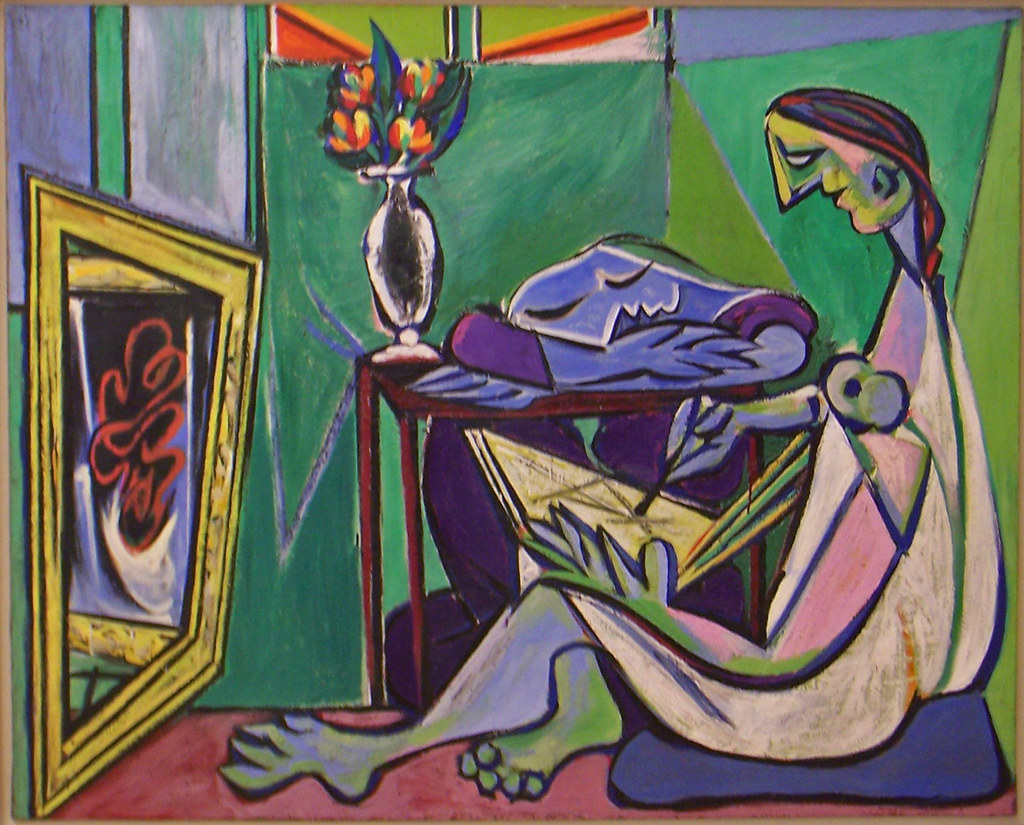
Author: Sebastià Giralt on Unsplash
The Picasso Museum is a perfect place for acquaintance with the works of this outstanding artist.
Barcelona played an important role in the life of Picasso, for example, his first exhibition was held in this city, in the art cabaret Els Quatro Gats.
The Picasso Museum was created in 1960 based on the collection of Jaime Sabartes, who was a friend of the artist. There were 574 works in the original collection. And when Jaime died in 1968, Picasso donated another 900 of his works to the museum.
There are 3,500 works by the artist in the museum's collection and walking through the exhibition, one can follow the changes in the master's creative ideas. You will see his best paintings, understand how his artistic style has been changing, learn more about his biography and be able to compare his biography and work.
The best of all in the museum are the early works of the artist, dating back to 1890-1917.
The museum is especially proud of the cycle of works called "Las Meninas" with 59 variations on the theme of Velazquez's painting "Las Meninas".
In addition to paintings, you will see collections of ceramics, books, and graphics.
In addition, the museum itself is located in several buildings, and all of them are historical monuments of the 13th-18th centuries - the Beringel d'Aguilar Palace (Palacio de Berenguer d'Aguilar) of the 15th century, the Palace of the Baron Castellet (Palau del Baró de Castellet) of the 13th century, The Palace of Mecca (Palau Meca) of the 14th century, the Palace of Finestres (Palau Finestres) of the 13th century and the House of Mauri (Casa Mauri) of the 18th century. So buying a ticket to the museum, you also get access to the history of Barcelona architecture and get a unique opportunity to look very closely at the walls made of small bricks, ancient arched ceilings, chic balustrades, and baroque balconies, patios with fountains with unusual decor, and one of the buildings, the House of Mauri, even the ancient Roman foundation has been preserved.
Museum opening hours and admission fees
The museum is open from Tuesday to Sunday from 9.00 am to 5.00 pm, and on Thursdays from 9.00 am to 9.30 pm.
The museum is usually open on public holidays but is closed on Mondays, as well as January 1, May 1, June 24, and December 25.
The museum has open days when anyone can visit it for free. Such days are held every Thursday from 6.00 pm to 9.30 pm, and the first Sunday of each month from 9.00 am to 7.00 pm.
You may buy the tickets at the cash desk or buy them online.
A 2-hour Pablo Picasso themed walking tour with skip the line ticket costs 35 euro. During this tour you will view interesting new locations such as the Llotja Mar, the art school where he studied, and Els Quatre Gats, the café he frequented. You will also explore the atmospheric La Ribera quarter, where Picasso had a studio before moving to Paris, and enjoy the Picasso Museum, home to over 4,000 of Picasso’s artworks.
If you want to get an extraordinary experience, order Barcelona: Private Picasso Experience for 221 euro. Informative and friendly guide will start the tour at Porxos d’En Xifre, where Picassolived when he was 13. Then you will visit the museum and enjoy the convenience of skip-the-line tickets and a stroll through the remarkable building, home to 4,251 works of the artist. And finally you will explore the neighborhood of Born, considered by the locals to be one of the city's most Bohemian areas. You will end the tour with a delicious coffee or tea in the Els Quatre Gats, Picasso's favorite place. This will be an unforgettable time full of beauty and art.
Montjuic mountain and fort
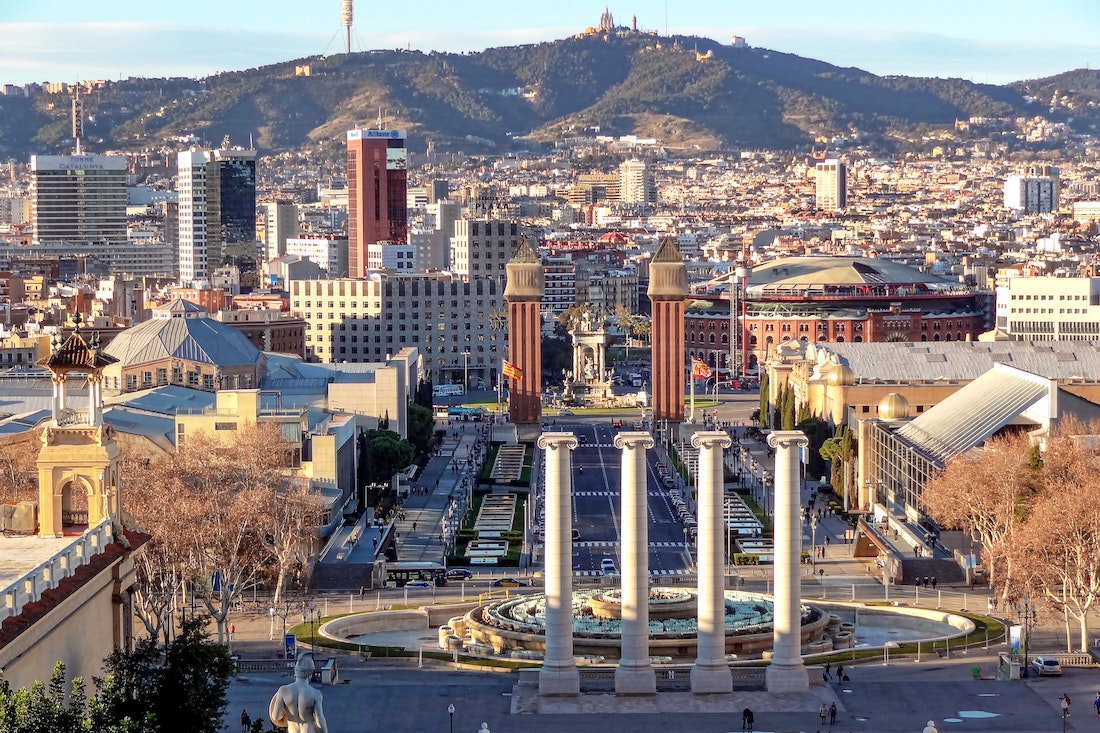
Author: Manuel Torres Garcia on Unsplash
One of the greatest attractions in Barcelona is the mountain and fortress of Montjuic and the cable car that rides to it.
Mountain and fortress of Montjuic
Montjuïc Fortress or Castell de Montjuïc stands on the mountain of the same name. This place has both historical and contemplative value.
The history goes that the fortress was built in 1640, during the Catalan rebellion against the official Spanish government in the face of the Austrian family of the Habsburgs. Less than 100 years later the fortress was captured by the British, then again by the Spaniards, and then in 1808 by the French under the leadership of Napoleon. Then, in 1940, on the territory of the fortress, on the orders of the dictator Franco, the President of Catalonia, Luis Companys, was shot (but this hero is so loved in Barcelona that the Olympic Stadium was named after him), and then for several years the fort served as a prison, and finally, Franco opened a military museum here.
Today people come here mainly to admire the gorgeous views of Barcelona and the sea. If you want to see more than beautiful views, visit the museum, which costs 5 euros to enter. There you will hear the history of the fortress and the whole Barcelona. You will also see different types of weapons, including cannons, which, by the way, can be seen from the outside for free. And 5 euros can be spent on a glass of sangria.
How to get to the fortress of Montjuic
You can get here on foot along the footpaths of Montjuïc, by city buses from Plaza España and by cable car from the city center and from the Barceloneta area.
The first thought is to climb the mountain on foot. It is possible, but in summer it may be very hot so you will be too tired to admire anything. But if you still decide on this option, then put on comfortable shoes, follow the signs and take plenty of water with you.
The second option is bus 55. It costs a couple of euros. Bus number 55 leaves from Pl. Urquinaona. Fast, convenient, cheap.
The third option and the most interesting one is the cable car. First, it's beautiful. You will see the entire central part of the city: the Rambla, Plaza Catalunya, the Sagrada Familia Cathedral, the Gothic Quarter, as well as the sea, beaches and the port with its beautiful yachts and liners, and of Montjuic itself. There are several places where you can take the cable car: the San Sebastia tower on Barceloneta beach (Torre de San Sebastia), Jaume I tower in the city port (Torre de Jaume I) and Montjuic Park (Parc Montjuic).
If you decide to buy an online ticket, please note that it is only valid when entering the Parc Montjuic station!
The Parc Montjuic station is convenient because there is a free funicular train going there. It departs from the Parallel metro station and goes straight to the cable car entrance. The train runs every 10 minutes. The fare is included in your City Pass, so you never have to pay extra for anything.
The cable car stops at an intermediate station called Mirador de Miramar Viewpoint and at the final station, where the fortress of Montjuic is located.
Cable car opening hours and prices
In January and February, the cable car is open from 10.00 to 18.00.
In March, April and May, the cable car is open from 10.00 to 19.00.
From June to September, the cable car is open from 10.00 to 21.00.
In October, the cable car is open from 10.00 to 19.00.
In November and December the cable car is open from 10.00 to 18.00.
A round trip ticket costs 13 euros. You can buy a ticket from the cable car box office or online if you do not want to stand in line. The gate inspector will scan the ticket from your phone, you don't even need to print it. Buy a ticket.
With this online ticket, you can enter and exit at any of these three stations: Parc de Montjuïc, Miramar, and Castell de Montjuïc.
Walking tour with Montjuic Castle & Cable Car costs 50 euros. During this special tour you will pass by the Boqueria Market and see the Old Town neighborhood, enjoy an impressive ride on the Montjuic Cable Car, and admire the Montjuic Castle with its ancient history and mysterious dungeons in a small group with a professional guide.
The Boqueria Market
In the 12th century, there was already a market on this spot. All the inhabitants of Barcelona knew that if you want to buy fresh food, you need to go to the Boqueria market.
This particular market was opened in 1840. The second name of the market is San Josep.
The architect of the market decided that the main part of the building would look like a classic French arcade, but the decor of the arcade obviously has Catalan features with wrought iron elements, an unusual signboard font, and stained glass windows.
Several times the Boqueria market was recognized as the best in the world and there is nothing to argue with because here you will find a huge selection of delicacies from all over Spain and Europe, the sweetest fruits, the freshest vegetables, gourmet sweets, fragrant Jamon and other meat, poultry and fish, spices, cheese, wine, and bread, in general, everything that the soul desires.
The prices here are not the lowest in Barcelona, however, there is always the opportunity to buy something at a very favorable price, for example, in the late afternoon, buy fruit at a discount or drink fresh or smoothies for 1 euro.
If you like seafood, then the shopkeepers from the fish stalls will not only sell them to you, but they will also cook them in the best possible way for very modest money.
The Boquería market is a great place to get acquainted with the gastronomic tastes of the Barcelona people and get immersed in the atmosphere of a shopping holiday.
Try Half-Day Spanish Cooking Class & Boqueria Market Tour for 94 euro during which you will learn to cook the best Catalan cuisine dishes, discover the secrets of La Boqueria Market, and prepare a 4 course meal using the tips from professional chefs.
Or visit La Boqueria and enjoy Spanish Seafood Paella Cooking Experience for 55 euros. Spend 3 hours with a chef and learn how to cook the best paella in your life .
L’aquarium Barcelona
Walking along the Rambla, you will sooner or later come to the city port, where you will find a large city aquarium. Both locals and guests of the city like to come here to relax and be inspired.
Barcelona Aquarium is one of the largest in Spain and Europe. This is the perfect place to relax if you have dreamed of walking through an underwater tunnel, when you seem to be walking along the seabed, and above you are just tons of water and millions of fish and there is no need to be in a hurry. The length of the tunnel is 80 meters, 100 people can be in it at the same time, so the crowds are not terrible here. Another interesting point is that you do not need to go through the tunnel, a moving walkway has been laid along it, so you get the feeling that you are also floating together with the sea world around you.
In addition to the tunnel, there are 35 aquariums in which a total of 11,000 marine life lives. Moreover, all of them are divided into 14 ecosystems, depending on the real habitat. This means that all residents of the aquarium are as comfortable as possible.
Large and small sharks, electric rays, dangerous eels, graceful octopuses, colorful jellyfish, clumsy crabs, sharp sea urchins, bright stars, as well as many turtles, chameleons, lizards live in the aquarium, and children are always delighted with funny penguins.
In addition to marvelous fish and other marine inhabitants, cafes, souvenir shops, a museum where you can learn many interesting facts about the underwater world, and a playground are open for you. In a special area, you can buy food for the fish, feed them yourself and even touch them with your hands. In addition, children can go inside a real submarine and there press the buttons, and feel like real submariners.
Opening hours and prices
The aquarium is open every day, but opening hours may vary depending on the season. The Aquarium always opens at 10.00 and closes in different seasons at different times, but always between 19.30 and 21.00.
The ticket costs 21 euros for adults, 16 euros for children from 5 to 10 years old, and 8 euros for children from 3 to 4 years old. Tickets can be purchased at the box office or you may buy them online if you don't want to stand in line. Online tickets are convenient because they do not even need to be printed, the controller at the entrance simply reads them from your phone.
Casa Vicens
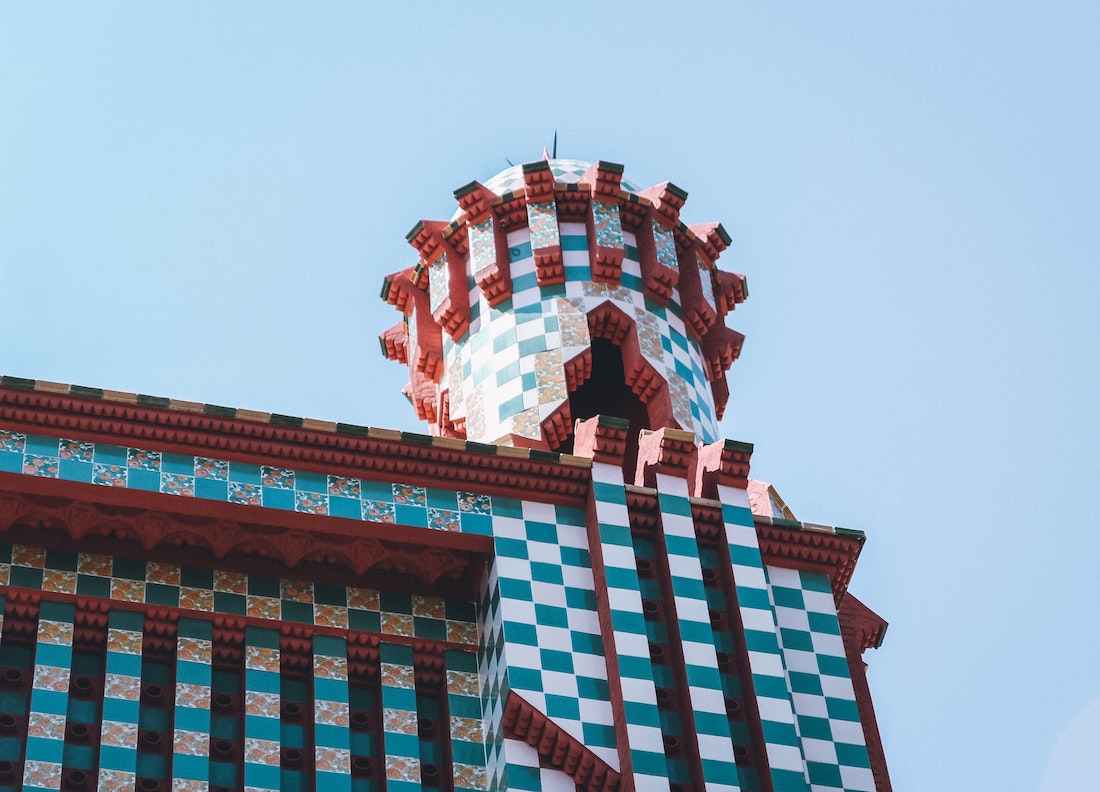
Author: Kristijan Arsov on Unsplash
Barcelona is decorated with a whole scattering of works by Gaudí. Among them is the House of Vicens.
The house is located in Barcelona's Gracia district.
It was 1878 and Gaudí had just received his degree in architecture. He is approached by the famous Catalan manufacturer Manuel Vicens with a request to build a house for him.
The house was planned as a summer residence. The building is built of raw stone and ceramic tiles. The tile symbolized the occupation of the owner of the house because Manuel Vicens owned a tile factory. And then Gaudi actively used the idea of tiled design when working with the Guell Palace and Park Guell. There is something to consider in the building - unusually shaped windows, turrets and chimneys, balconies, and numerous ledges. All elements give the house volume and elegance. You can look at the patterned forged balconies, outlandish lanterns and angels sitting on the ledges for a long time and you will not get tired.
Stylistically, the building is modern with Mauritanian elements. For Gaudi, this was an important step that determined the direction of his entire creative path.
There is no furniture inside the building, but you can see the marvelous design of walls and ceilings, windows and balconies, admire floral ornaments and the play of light, relax by the fountain and walk along the terrace and shady park. Unlike the houses of Mila or Batlló, there are no crowds of tourists here, so all the beauty of the house is at your disposal.
Opening hours and prices
From October 1st to March 31st
Mon: from 10.00 to 15.00
Tue-Sun: from 10.00 to 19.00
Closed January 25th and January 6th.
April 1st to September 30th
Mon-Sun: from 10.00 to 20.00
On May 22, admission to the museum is free for everyone.
Please note that the box office closes 1 hour before the museum closes.
Tickets can be purchased at the box office or you may buy an online ticket. Online tickets do not need to be printed, the controller will simply scan them from your phone.
Basilica Santa Maria del Pi
One of the most beautiful Gothic churches in Barcelona stands in the Gothic Quarter and is called Santa Maria del Pi or Saint Mary of the Pine.
Previously, there was a pine forest in this place, then a temple was built, the forest gradually disappeared, but the name remained. One pine tree was planted in memory of the former forest in front of the temple.
Some say that the temple stood on this spot at the beginning of the second millennium, but this particular cathedral was built in 1320. The building was reconstructed and rebuilt more than once, because, in the long history of its existence, everything has happened to it: a fire, an earthquake, and even an explosion of a powder keg.
The last reconstruction took place in 2009 and the architects tried to bring the appearance of the cathedral as close as possible to the original.
The most unusual part of the church is the bell tower. It has eight corners and it resembles a huge pipe or a tower of unusual shape. At the top of the bell tower there is an observation deck that offers views of the city center and the coast.
The building is built in the Gothic style and has all the characteristic elements: a beautiful portal, a large wind rose, stucco, vaulted ceilings and a massive altar. Concerts are often held in the temple, and on Sunday you can come to worship, it's free. We advise you to dress in more urban clothes - long trousers or a dress.
The entrance to the temple as a tourist costs 4.50 euros, and you can climb to the observation deck for 9 euros.
And the best way to observe the whole city is Helicopter, Walking, and Sailing 360º City Tour for 129 euros. It allows you to enjoy the best Barcelona views by land, sea and air.
Mirador de Colom
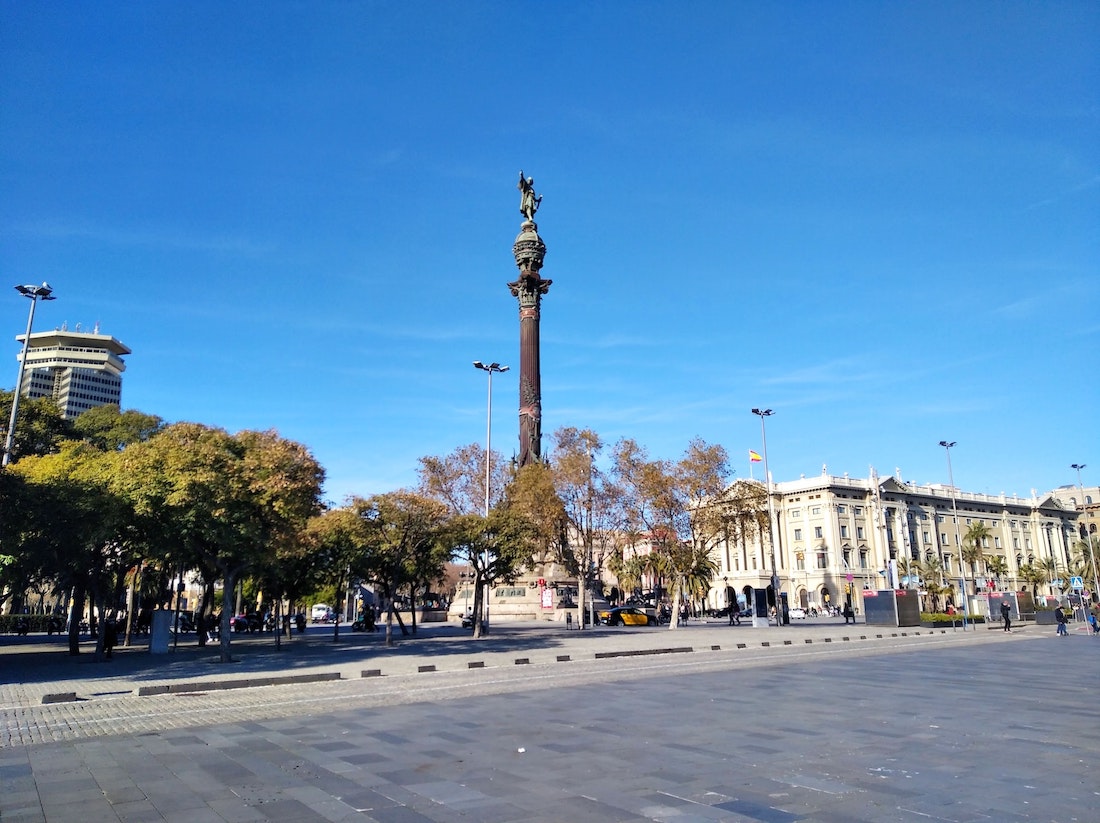
Author: JOE Planas on Unsplash
A huge monument to Columbus stands on the Plaça Portal de la Pau.
On one side of the monument lies the vibrant Rambla, full of city entertainment, hotels, and cafes. You will also see the city port, Aquarium, and Barceloneta beach.
A monument is 60 meters high and it has been decorating the square since 1988. A 7-meter bronze statue of Columbus stands on top of a 40-meter Corinthian column. One hand of Christopher Columbus points toward the New World, and in the second he holds a scroll. In fact, Columbus points rather toward Algeria than toward the New World. But the main thing here is the idea, not the direction.
The monument commemorates the return of Columbus to Barcelona after the First Voyage to America. That voyage lasted eight months, from August 3, 1492, to March 15, 1493. After the trip, Columbus arrived in Barcelona to report to Queen Isabella I and King Ferdinand II.
Observation deck at the Columbus monument: opening hours and prices
From 60 meters high you will see a stunning view of the whole of Barcelona. You will enjoy the view of the brilliant city center, tourists strolling along the Rambla, people relaxing on the beaches, sailors hurrying to the port. At the very top, you will have the opportunity not only to admire the city, but also to taste delicious Catalan wine and even buy a couple of bottles to take with you. Although in the store the same wine will cost less.
The observation deck is open every day from 8.30 to 20.30
The entrance ticket costs 8 euros. You may buy your online ticket.
Placa Reial
There used to be the Capuchin monastery of Santa Madrona, on the site of the square. But the monastery burned down in 1835. In the second half of the 19th century, it was decided to build a square on the site of the monastery and call it Royal.
Today the square is a place of attraction for guests and residents of the city. There is an elegant fountain in the center of it, where it is so pleasant to cool off in the heat, tall palm trees are planted near the fountain, creating a pleasant shade. You will also see nice cafes, restaurants, hotels, and souvenir shops. Prices are high, but you know that you pay for a luxurious entourage.
If you love jazz, go to the Jamboree club located on the square. Performances usually begin around midnight. Virtuoso guitar playing, songs with Spanish motives, and flamenco create an absolutely unique atmosphere, and the entrance costs only 5-10 euros.
A special attraction of the square are the black forged lanterns, which were designed by Antoni Gaudí. These lanterns were his first order from the city government.
This location is a perfect choice to stay, so you may choose one of the nearby hotels. Hostal Fernando offers nice small and cheap rooms, single or for the whole family, Cuatro Naciones is located in an 18-th century building and features amazing interiors. And H10 Madison 4* Sup allows you to enjoy the luxurious rooms, an outdoor swimming pool with a spacious terrace overlooking Medieval churches of the Gothic Quarter.
Placa de Sant Jaume
The square is located in the Gothic Quarter of Barcelona.
In the Middle Ages, the Cathedral of St. James was located here, then it was destroyed, moved, and rebuilt, but despite all the changes, the name of the square remained the same.
Today, the square houses several administrative buildings, including the City Hall and the Government of Catalonia, as well as many souvenir shops and cafes. Usually, fairs and festive events are held here, and if protest moods capture Barcelona, the crowd comes to express themselves closer to the city administration.
The square is located in the Gothic Quarter but most of the buildings are built in the style of classicism and renaissance. For example, the City Hall was built of light stone and decorated with arches and columns, and the architecture of other buildings is rather restrained and differs from the majestic Gothic style very much.
La Fundacio Joan Miro
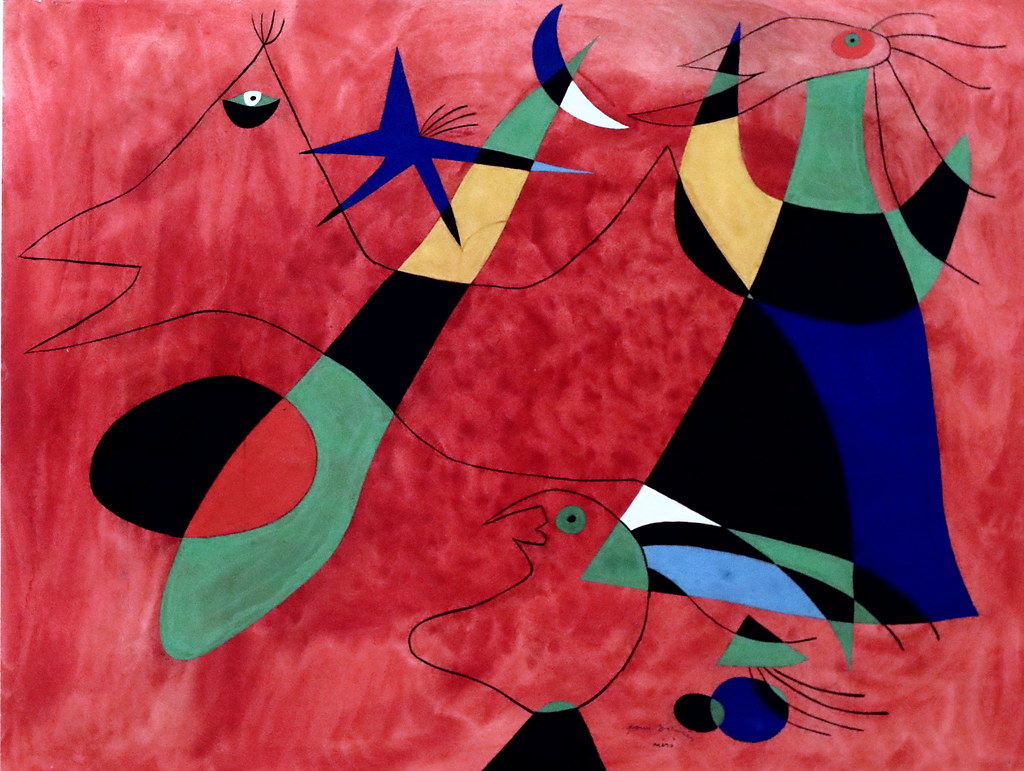
Author: jean louis mazieres on Unsplash
The Joan Miró Foundation is a large contemporary art museum located in the Montjuïc Park in Barcelona.
Everything is wonderful in this museum - the modern architecture of the building, and works of art, creative people who come here, and the atmosphere that reigns in each corner. It is worth coming here if you love contemporary art, if you want to understand it and if you like abstract art in general and the work of Joan Miro in particular. And if you have not heard anything about Miró, but are delighted with Picasso, you should again come and learn a lot of new things.
Exhibitions and expositions
Joan Miro is a well-known Catalan artist who mainly worked in the style of abstractionism and surrealism. Miro was born, studied, and worked in Barcelona. In 1920 in Paris he met Picasso and other artists of that period. In 1937, fleeing the horrors of fascism, he moved to Paris, where, despite the hard time, he worked fruitfully - he painted the walls of hotels and restaurants and even the Paris branch of UNESCO, created frescoes and pictures, as well as anti-fascist posters. As a result, the artist remains to live in Paris, but dies at the honorable age of 90 in sunny Palma de Mallorca.
Those who are fans of the artist and lovers of a beach holiday will surely like the idea of staying at the Joan Miro Museum Hotel.
Hotel Joan Miró Museum is located by the sea in Palma de Mallorca. The hotel rooms are decorated with Joan Miró originals, the Miró Museum is situated across the street and the beach is a short walk away. In summer, a room in such a hotel costs for 120-150 euros, and in autumn it is even cheaper.
Museum architecture
The building was designed by Josep Lluis Sert, who was a friend of Joan Miro. He also was a student of Le Corbusier himself, who became the founding father of modernism and functionalism in architecture. Josep Sert has built more than five buildings in Barcelona, but this is one of the most remarkable. A large and bright building stands in the middle of the emerald hillside of Montjuic. The sun's rays reflect off the building, making it even whiter. There is a patio inside the building, and the exhibition halls are grouped around it.
There is an open terrace on the roof of the museum where you can look at sculptures and admire them.
Gift shop and cafe
If you are looking for original souvenirs and a delicious lunch, welcome to the shop and cafe.
The store sells art books in Spanish, Catalan and English, notebooks and sketchbooks, pens, pencils and paints, keychains and magnets, postcards, jewelry and many interesting things.
And in a stylish cafe, you will be served delicious coffee and fresh pastries.
Opening hours and prices
The museum's schedule changes depending on the season. Usually it closes at about 20.00 but sometimes at 18.00
The entrance ticket costs 14 euros. Visitors under 15 years old enter for free.
Tickets can be purchased at the box office or you may buy an online ticket.
